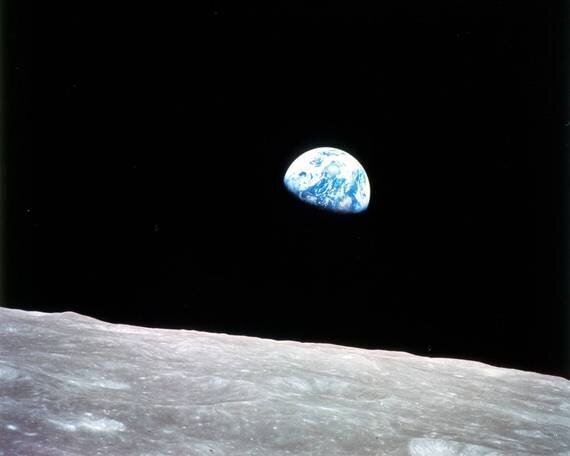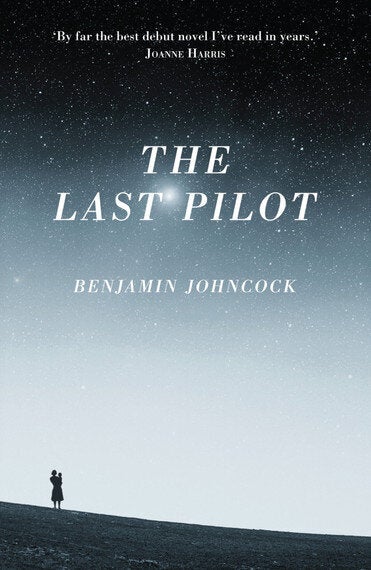
(Image: NASA)
248,655 is the most significant number in NASA's history.
That's the farthest, in miles, our species has ventured from our home planet.
Lovell, Haise, Swigert; Apollo 13; swinging around the far side of the moon to return them home. It's a record that's stood for nearly half a century, and doesn't look like it's going to be broken any time soon.
It was the writer Andrew Smith who observed that the further we get from Apollo, the stranger it looks.
Did a man, born on a farm during the Great Depression, really travel into space and walk on the moon? Or was it just some collective mass hallucination; a by-product of the sixties?
Norman Mailer wasn't exaggerating when he said that Armstrong's lunar landing was the "the climax of the greatest week since Christ was born".
But Apollo 8, in December 1968, was arguably the bolder leap - humans leaving the cradle for the first time, venturing out of Earth orbit and into deep space.
Apollo 8 was a ballsy move by NASA, driven by a rapidly approaching political deadline. To consider the mission dangerous was the mother of all understatements. Frank Borman, Jim Lovell and Bill Anders were to travel a quarter of a million miles to the moon, enter lunar orbit, spend 20 hours, 70 miles above the surface, then fire the SPS engine to bring them out of lunar orbit and home.
Borman figured their chances of making it were fifty-fifty.
As well as being the first to orbit another celestial body, Borman, Lovell and Anders were also the first people to see the far side of the moon (forever turned away from the Earth). Anders also took one of the most famous and influential photographs of all time: NASA image AS8-14-2383, "Earthrise".
On Christmas Eve the crew broadcast to the largest television audience to the date - around a quarter of the Earth's population - and read from the book of Genesis. It was a profound moment in the most historically significant mission of the entire space programme, which is why I chose to include it in my novel, The Last Pilot.
We're nearly fifty years on from Apollo now, the Space Shuttle has been retired to museums, the First Man has gone, and we've come to accept that the first generation to witness humans leaving the Earth looks likely to be the last.
You can send a probe to Pluto, a rover to Mars, but neither can tell you what sunrise feels like there.
A frontier without a human being standing on it is nothing more than a line in the red dust or the stars.
However, as 2015 draws to a close, it feels like there's something in the air.
Is public opinion about manned spaceflight beginning to shift for the first time since 1969?
NASA's discovery of evidence that liquid water flows on today's Mars feels like the climax to a buildup of interest and excitement surrounding space exploration that hasn't been seen in years.
From the Curiosity Rover, Rosetta's touchdown on a comet, the incredible photography of Pluto by the New Horizons probe to Chris Hadfield's global celebrity and a collective nostalgia about the Space Race of the fifties and sixties. Something is definitely happening.
The world's media is rapt, and people across the globe are getting exited about manned space exploration again.

As ever, the movies of the time reflect this: look at The Martin, Interstellar, Gravity. And The Last Pilot is set in the Space Race era, which is why the Washington Post called it "nostalgic and heart-rending".

Human footprints on the Red Planet suddenly seem within reach. NASA is planning for this very mission in the 2030s.
A surefire sign of this resurgence are crackpot schemes like Mars One, multimillionaire Dennis Tito's Inspiration Mars Foundation, Mars To Stay and the Mars Homestead Project ("To Arrive, Survive & Thrive!™").
Even the moon is getting some of this lunacy in the form of Lunar Mission One's "Footsteps On The Moon" project, which invites you to upload a photograph of your smelly feet to a "digital payload" aboard an "astrobotic moon lander" scheduled for launch in 2017, so we can all "stand on the moon, in peace, together".
This year's World Space Week is perhaps the most exciting yet.
Manned space exploration speaks to something deep within us as humans - it remains the purest, most tangible expression of the question, why are we here? And the greatest daily reminder of the mystery of life is the night sky.
As a species, we've been looking up and wondering since the very beginning.
We've not lost the yearning to go, but without the geopolitical urgency of the Space Race - and with a myriad of problems here on Earth - many have found the cost of manned space exploration hard to stomach.
But where did we get the notion that the answer to the problems on Earth are to be found on Earth?
In an infinite universe, isn't it infinitely more likely that the solutions exist outside of our own atmosphere?
It's strange to think that the 20th century started with horses and finished with spacecraft. I wonder how the 21st century will end.
